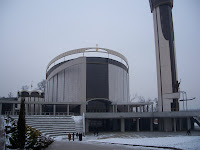day 7: 1 jan 2008

the feast of Mary Mother of God is today and we went to the shrine in Czestochowa, the monastary of Jasna Gora where there is the icon of the "Black Madonna". this place was more than i expected it to be. it is a castle turned into a monastary, it was there that twice the intercession of Our Lady of Czestochowa was invoked and the city saved from opposing armies. outside the castle walls are huge and moving bronze stations of the cross made around 1900. inside above the chapel of Our Lady there are paintings of the stations with the Polish history in the background which are also very moving-made around 2000. around the field surrounding the castle are statues marking the 20 mysteries of the rosary. this place is built for prayer, i wanted more time there to pray.

everything here has permenance-solidly built and meant to last, perhaps it is a message that co
mes from their faith. there were 2 chapels side by side with Mass going on each hour of the day--all full. there was so much significance there, i wasn't preparred to process it. as you entered the shrine area a sign read: "this is a holy place, enter as a pilgrim" i would like to heed that more next time. this was our last day in Poland. that night we would go to dinner with the brothers that hosted us, listen to the bugler of Krakow toot his horn, then rise early to leave home--it was sad to leave. i read Spe Salvi while i was here and that was a real spiritual boost to the trip. if i were to come again, i would want to spend more time at Czetochowa and the Divine Mercy Shrine. it would be good preparation to read a little about the bugler of Krakow, Our Lady of Czestochowa, Jasna Gora itself, and some of Sr. Faustina's Diary.
pictures:
1- Jasna Gora from afar
2- an outdoor reproduction of the icon of Our Lady of Czestochowa
3- an outdoor station of the cross (Christ is nailed to the Cross)
4- a polish station of the cross (Christ dies on the Cross)
5- me with superior tactical advantage as we had a little snowball war on the walls of Jasna Gora
6- our last dinner in Krakow (Aaron, Br. Benedykt, Jeff, me, Chris)



